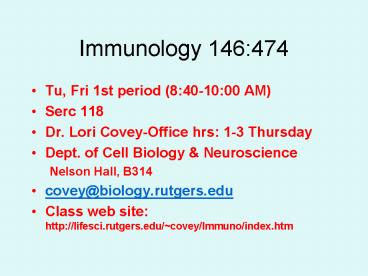Immunology 146:474 - PowerPoint PPT Presentation
1 / 41
Title:
Immunology 146:474
Description:
Each heavy chain gene has a membrane-coding (MC) and a secretion-coding (SC) exon. ... Cytomegalovirus accelerates retrograde translocation of MHC class I molecules ... – PowerPoint PPT presentation
Number of Views:46
Avg rating:3.0/5.0
Title: Immunology 146:474
1
Immunology 146474
- Tu, Fri 1st period (840-1000 AM)
- Serc 118
- Dr. Lori Covey-Office hrs 1-3 Thursday
- Dept. of Cell Biology Neuroscience
- Nelson Hall, B314
- covey_at_biology.rutgers.edu
- Class web site http//lifesci.rutgers.edu/covey/
Immuno/index.htm
2
Figure 4-21 part 2 of 2
3
Membrane and secreted form
- Each heavy chain gene has a membrane-coding (MC)
and a secretion-coding (SC) exon. - Each mRNA transcript has 2 cleavage sites for
polyadenylation (pAm and pAs) - Membrane form-25 amino acid hydrophobic tail
- Secreted form- has a hydrophilic COOH end
4
(No Transcript)
5
All isotypes are expressed as a membrane and
secreted form
Membrane form-specific cleavage and
polyadenylation
6
Membrane and secreted form, contd
- Resting, naïve B cells express membrane IgM and
IgD. - In late-stage plasma cells-almost all the
expression is secreted form
7
Somatic hypermutations create diversity
- Occurs later after B cells are in secondary
lymphoid organs - Introduces single nt mutations into germline DNA
- Results in increased binding affinity of antibody
for antigen
8
Somatic hypermutations create diversity
9
Figure 4-9
Important enzyme involved in this process called
activation induced cytidine deaminase or AID
Requires transcription
10
Antigen Processing
- Generation of peptides from intact proteins to be
displayed by MHC Class I and Class II molecules - Antigen Presentation
11
2 major intracellular compartments
- Cytosolic which includes nucleus.2. Vesicular
system ER, golgi, endosomes, lysosomes
12
Infectious agents can replicate in two distinct
compartments of the cell
Viruses and some bacteria replicate in cytosol
13
Two functional classes of CD4 T cells TH1
cell--gtactivate macrophage to kill intravesicular
bacteria within macrophageTH2 cells--gtactivate
B cells to make antibodies
Th1 Th2
14
Peptides that bind MHC class I are transported
from the cytosol to the endoplasmic reticulum (ER)
The MHC class I molecules are synthesized in the
cytoplasm and transported through ER
15
Transporters associated with antigen
processing--gt TAP1 and TAP2
Form a heterodimer that is a peptide transporter
in the ER membrane--gtrequires ATP hydrolysis
16
Figure 5-3
17
Generation of peptides in the cytosol
Carried out by the proteosomeLarge,
multicatalytic protease complex.
18
ProteosomeCylindrical complex of 28 subunits,
arranged in four stacked rings, each of 7
subunits. Hollow core thats exposed to the
catalytic sites. Proteins enter hollow core and
then broken down into short peptides and released
19
Horizontal cross-section
Longitudinal section
Proteins unfold and enter proteosome
20
Three proteosome subunits--gtb1i, b2i and
b5i Expression is induced by interons ? and ?
Substitute for 3 subunits of proteosome
subunits---gt immunoproteasome
Three inducible subunits, and counterparts--gt
active proteases of proteosome or immunoproteasome
21
Difference between proteasome and
immunoproteasome?
1. Change protease preference produces peptides
with carboxy-terminal residues that are preferred
anchor residues for binding to MHC class I
molecules
2. Preferred peptides for binding by TAP1/2
22
PA28 proteasome-activator molecule
Induced by IFN-? Binds to both ends of
proteasome increase rate at which peptides can
be released ?
23
Endoplasmic reticulum aminopeptidase associated
with antigen processing ERAAP
Peptides transported into lumen of ER, enzyme
trims peptides from amino end that dont fit into
MHC class I molecules ?
24
MHC class I molecules are assembled in the ER
25
MHC class I molecules are assembled in the ER
Association of MHC class I ? chain with calnexin.
Binding of ?2microglobulin displaces
calnexinMHC class I ? chain and ?2m binds to
calreticulin and tapasin
26
Tapasin binds to TAP1 and TAP2
27
Figure 5-6 part 2 of 2
28
Viruses have evolved mechanisms for interfering
with MHC class I expression
Herpes simplex virus--gt produces proteins that
bind TAP prevents movement of peptides into ER
Adenovirus--gtencode a protein that binds to MHC
class I molecules and retains them in the ER
29
Mechanisms, contd
Cytomegalovirus accelerates retrograde
translocation of MHC class I molecules back into
the cytosol--gtdegraded.
30
Parotozoan parasite LeishmaniaMycobacteria
that causes leprosy and tuberculosis replicate
inside intracellular vesicles in macrophages.
31
Peptides generated for loading into MHC class II
molecules
Intracellular pathogens that replicate in
intracellular vesiclesEndocytosis--gtendosomesPh
agocytosis--gtphagosomesReceptor-mediated
endocytosis, i.e recognition of antigen by
antibody
32
Peptides generated for loading into MHC class II
molecules
33
Cathepsins important proteases for processing
vesicular antigens
34
MHC-class II-associated Invariant chain
Forms trimers with each subunit binding
noncovalently to an MHC class II ?? heterodimer
Part of polypeptide chain lies within the
peptide-binding groove
35
Invariant chain forms trimers
Assembled in ER
36
Only after transport into acidic vesicle,
invariant chain is cleaved
Protected from binding peptides in ER
37
CLIP protein binds to the groove
MHC class II molecules cant bind other peptides
38
Figure 5-10 part 1 of 2
39
Loading of MHC class II molecules with peptide
HLA-DM--gt found in the MIIC compartmentBinds to
MHC class II molecules catalyzes the release of
CLIP
40
Binding of peptide to MHC molecule is irreversible
41
Figure 3-19































